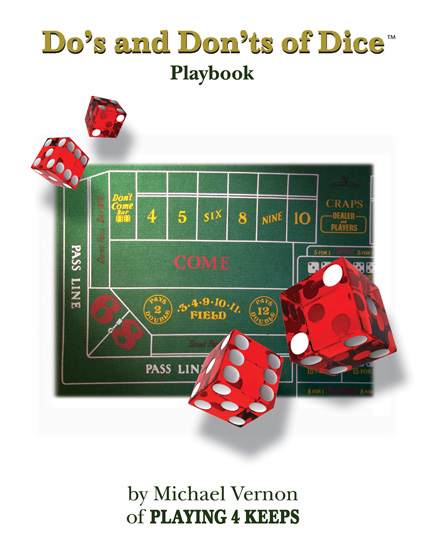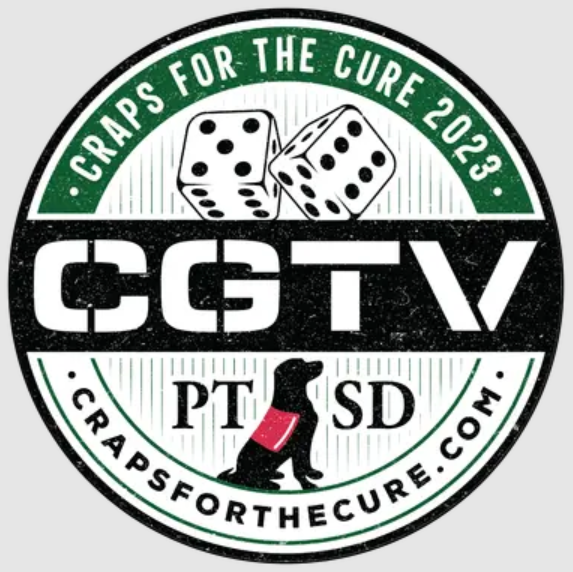|
Distance Between Sevens
BY: Mike From Hawaii
There are two primary ways to do Craps math. One is the way God would do the Math (Capital M). To infinity and beyond! as a certain toy super hero likes to yell.
The other way is to "Monte Carlo" it. By that we mean make a "machine" on which you can turn the "crank". In this case a Craps shooting machine. It simulates throwing the dice a LOT of times! and allows you to record the results.
I wrote one in a language called C and can run it on a very powerful computer. Boy does it shoot Craps! In about 1 second it can shoot the dice about 2/3rds of a million times and record all sorts of interesting statistics. (It is not really the computer that makes the difference, it is the simplicity of the code. No animations, no graphics, no dice layout, nothing but bare minimum gears and wheels.)
As for the data, Seven appears (111288 / 667722) times or 16.6668% of the time. Very reassuring since God Math would say exactly 1/6th of the time or 16.6667% of the time you should find a Seven. Keep in mind that throwing Seven is the most common thing that can happen in Craps.
Originally I had it using just 10,000 rolls of the dice. Sounds like a lot, but it is impressive how skewed the data on some of the less common outcomes such as hardway 4's turned out. In fact even the number of Sevens could be off by quite a bit in only 10,000 rolls. So I upped the ante until I found a number that would give me some statistics I could believe in. That started to happen when I got to about 500,000 rolls. (More on this later.)
Where did I get my random numbers? Well random.org of course. Assembled in batches at random times over a number of sessions over the period of a week.
So how many hands in 667,722 rolls? 197,905. That would be the average length of a Craps hand, if you define "hand" as the series of events that starts with a comeout roll, ends with immediate crap out, or an immediate win with 7 or 11, or sets a number and continues rolling until you either make that number or Seven Out.
In other words the series of events from when you first pick up the dice until there is something that results in a decision. The program says that number is about 3.37 rolls of the dice on average.
Some might object to my use of "hand" for this. Saying a "hand" is from when you first get the dice until you have to pass the dice. I have not taught my little engine to capture that exact data yet.
So what does the little engine have to say about the distance between Sevens? Before you peek answer this question:
What is the most common, most likely, distance between Sevens in Craps?
ZERO! Yes indeed. The most common distance between Sevens in Craps is no distance at all! The most common distance is consecutive Sevens.
That one had me chasing my tail for a bit. I could not get my "Sevens" to add up. Finally the light came on. I was recording all distances between Sevens from 1 to 127 and a whole bunch were missing! Duh.... When I fixed the program to carefully record consecutive Sevens, shazzam, like Bo Peep, I found all my missing sheep.
In fact, there were 18,539 consecutive Sevens out of a total of 111288. That is 16.66% of the time. WOW! Bingo! What is the chance of rolling a Seven on any given throw? One in Six. or 16.6667%. Choirs of Angels Sing. (As they say when Math works). Hard core proof that given enough throws, dice in fact seem to have no memory.
So what about the other Monte Carlo distances:
Gap # Percent Cumm.
0 18539 16.66% 16.66%
1 15632 14.05% 30.71%
2 12684 11.40% 42.10%
3 10706 9.62% 51.72%
So four rolls of the dice cover just over half of the possible cases. Starting from a Seven and then hitting Seven again on the very next, second, third or fourth roll.
What is scary for certain strategies is the rest of this chart. It fades away, but because there is fully a 5/6th chance the next number will NOT be a Seven, it does not fade away that fast.
The Rest of the data out to a gap of 25 between Sevens. This really starts to enter the Twilight Zone:
Gap # Percent Cumm.
4 9023 8.11% 59.83%
5 7380 6.63% 66.46%
6 6209 5.58% 72.04%
7 5286 4.75% 76.79%
8 4320 3.88% 80.67%
9 3574 3.21% 83.88%
10 2985 2.68% 86.57%
11 2426 2.18% 88.75%
12 1973 1.77% 90.52%
13 1765 1.59% 92.11%
14 1517 1.36% 93.47%
15 1274 1.14% 94.61%
16 1001 0.90% 95.51%
17 788 0.71% 96.22%
18 729 0.66% 96.88%
19 614 0.55% 97.43%
20 471 0.42% 97.85%
21 413 0.37% 98.22%
22 336 0.30% 98.52%
23 293 0.26% 98.79%
24 223 0.20% 98.99%
25 195 0.18% 99.16%
There is one case of a gap of 72 rolls! The first zero appears at a gap of 54 rolls. Two cases of 55 rolls, one case of 57 rolls, two cases of 59 rolls, and one case of 65 rolls between Sevens. Every gap of 50 or less has at least several occurrences. From 29 to 40 every gap has 10 to 92 occurrences. From 28 down there are at least 115 occurrences.
By Math (Capital M)
We have stated that we are going to start with a Seven so the chances of the first number being a Seven are 100%.
The chances the next number will be a Seven are the same as the chances you will get a Seven any time you roll the dice (random roller of course). 1/6th or 16.67%
So what about the other numbers? Well the chances of NOT getting a Seven are 5/6th. So the chances of skipping one number are:
1 * 5/6 * 1/6 or .1389 or 13.89% = the chances of a distance of one gap between two Sevens.
For larger gaps you just multiply by more 5/6th's
1 * 1/6 16.67% 0 gap
1 * 5/6 * 1/6 13.89% 1 gap
1 * 5/6 * 5/6 * 1/6 11.57% 2 gap
1 * 5/6 * 5/6 * 5/6 * 1/6 9.65% 3 gap
Total so far: 51.77%
Notice several things here. First these numbers do not exactly match those from the Monte Carlo even though we used nearly 668,000 rolls. They are close, life is good, they do agree, the Monte Carlo at about 2/3rds of a million rolls is working OK. But it is not perfect! Expressed as percentages we are still getting errors in the first decimal place even with these "very common" occurrences.
Gap Percent Cumm.
0 16.67% 16.67%
1 13.89% 30.56%
2 11.57% 42.13%
3 9.65% 51.77%
4 8.04% 59.81%
5 6.70% 66.51%
6 5.58% 72.09%
7 4.65% 76.74%
8 3.88% 80.62%
9 3.23% 83.85%
10 2.69% 86.54%
11 2.24% 88.78%
12 1.87% 90.65%
13 1.56% 92.21%
14 1.30% 93.51%
15 1.08% 94.59%
16 0.90% 95.49%
17 0.75% 96.24%
18 0.63% 96.87%
19 0.52% 97.39%
20 0.43% 97.83%
21 0.36% 98.19%
22 0.30% 98.49%
23 0.25% 98.74%
24 0.21% 98.95%
25 0.17% 99.13%
What is the house advantage when you bet the passline and take double odds? Expressed as a percentage it is down in the first decimal place. And this data represents about how many dice rolls a dedicated shooter throwing once a minute, 24 hours a day, seven days a week for over 15 months might make. Now that is a session. And still there is "noise" in the Monte Carlo data even with this most common of events. And we are only looking at absolute errors. A better idea of the "noise" would be to look at the relative error size which in this case is six times larger.
How Noisy is 10,000 Rolls?
Noise in this case is error. As pointed out before there are two ways to try to analyze a betting system or the probability of something happening. You can try to calculate it using Math. Or you can build a model of it that carries out the steps of the game over and over again like a little mechanical version of the game, turn the crank and keep track of what happens over time.
With Craps there are 36 possible outcomes just on the roll of the dice. That is a LOT.
As questions get more complicated and you look at events that are relatively rare, the number of turns of the crank required on such a simulation or Monte Carlo starts to either become extremely large, or the data wobbles around so much it becomes almost nonsense due to the overly small sample.
One might think that 10,000 rolls is a reasonable number. So let's have a look at what happens when we Monte Carlo Craps with a bit over 10,000 random rolls, 66 times, using a different set of 10,000 random numbers each time.
In terms of hands, that is defining a "hand" as pick up the dice, throw them, either win immediately with Seven or 11, or crap out immediately, or set a number and then continue until you Seven Out or make your point. Start throwing dice, reach, one of the above conclusions. On average the slightly over 10,000 random rolls generate approximately 3,000 such hands. So that again sounds like a LOT.
Let's just look at two things that can happen frequently, and make up fully one third of all comeout roll results on average. You either (A) win with 7 or 11, or you (B) crap out with 2, 3, or 12. The odds on the first result is a nice clean 2/9ths. The odds on the second result is a nice clean 1/9th. As percentages those are: 22.22% and 11.11% for a total of 33.334% of what happens to all comeout rolls. (The other 2/3rds of the time you set a point and have to try to make it).
Let's begin with a very carefully selected example from the 66 trials. It is enough to make Angels weep. There are 2,971 "hands" in this run which generate 659 wins with either 7 or 11 on the comeout roll. And generate 332 loses with 2, 3 or 12. That is an absolute error of only -0.04% on the immediate win column (22.18% vs. 22.22%) and only 0.06% on the loss column (11.17% vs. 11.11%). Even viewed as relative error it is just -0.19% on the win column and 0.57% on the loss column.
Now what is the big deal? What is wrong with that!! Well very little. But this was a most carefully selected example from the 66. The majority of these runs have rather nasty errors. The absolute errors on the win side go from -1.79% (too low) to 1.57% (too high). Something that is supposed to be happening 22 percent of the time off by over a full percent much of the time. In relative terms it is a shocking -8.06% to 7.09% off base.
The loss side which is supposed to be happening 11% of the time has similar absolute errors, ranging from -1.56% (too low) to 1.29% (too high). In relative terms that is a horrifying -14.05% to 11.59%. Yes that is over 11% relative error on one side and 14% relative error on the other side. With 10,000 rolls!
So what does that mean for a real Craps session of (be generous) 250 rolls? Well chances you will see percentages like the Math (Capital M) predict for even the most common occurrences are not good. Any real Craps session is most likely to be significantly off on its probability distributions.
Even at 10,000 rolls of the dice, the numbers are not settling. Even at 2/3rds of a million rolls the less common events are still drifting off the absolute values calculated by Math, such things as the number of 12's, the number of hardways, and even the number of times someone will set a four and then make their point.
Whenever you extract a real life subset of dice rolls at a Craps table, you will very likely get something significantly different than the razor edged, 10,000th or an inch, ultra balanced, spun and serial numbered precision of infinite Math probabilities.
Next time someone says "I tested my system on WinCraps with 1000 rolls and it works!", Please raise at least ONE eyebrow...
©Aug 2006 Mike in Hawaii
Click Here to return to the list of prior articles ...
|
 |










